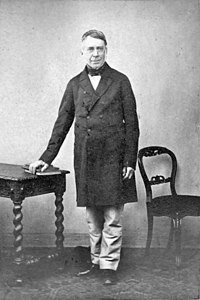George Biddell Airy
George Biddell Airy PRS, KCB (Alnwick, Northumberland, 27 de julho de 1801 — Greenwich, Londres, 2 de janeiro de 1892) foi um matemático e astrônomo britânico. Foi Astrônomo Real Britânico, de 1835 a 1881.
| George Biddell Airy | |
|---|---|
| Nascimento | 27 de junho de 1801 Alnwick, Northumberland |
| Morte | 2 de janeiro de 1892 (90 anos) Greenwich, Londres |
| Nacionalidade | britânico |
| Cidadania | Reino Unido da Grã-Bretanha e Irlanda |
| Filho(a)(s) | Wilfrid Airy, Hubert Airy, Christabel Airy, Hilda Routh |
| Alma mater | Colchester Royal Grammar School, Trinity College (Cambridge) |
| Ocupação | matemático, astrônomo, físico, professor universitário, escritor |
| Distinções | Prêmio Smith (1823) Medalha Copley (1831) Medalha de Ouro da RAS (1833), (1846)[1] Prêmio Lalande (1834) Medalha Real (1845) |
| Empregador(a) | Universidade de Cambridge |
| Instituições | Universidade de Cambridge, Royal Society |
| Campo(s) | astronomia, matemática |

No período como Astrônomo Real Britânico, estabeleceu Greenwich como localização do primeiro meridiano. Sua reputação foi abalada pela alegação que, devido à falta de ação de sua parte (em 1843 ele rejeitou os cálculos de John Couch Adams sobre a possibilidade de um 8º planeta influindo sobre Urano), o Reino Unido perdeu a prioridade da descoberta de Netuno.
Foi Professor Plumiano de Astronomia e Filosofia Experimental (1828–1836).
A cratera lunar Airy (cratera lunar) e outra em marte são denominadas em sua homenagem.
Engenharia
editarMétodo da Função Tensão
editarEm 1863, Airy publicou uma nova técnica para a determinação dos campos de deformação e tensão em uma viga de Euler-Bernoulli.[2] Esta técnica, denominada Método da Função Tensão de Airy, pode ser usada para a determinação de soluções de vários problemas da mecânica dos sólidos bi-dimensional.
Publicações
editarUma lista completa dos 518 papéis impressos de Airy está em Airy (1896). Entre os mais importantes estão:
- (1826) Mathematical Tracts on Physical Astronomy
- (1828) On the Lunar Theory, The Figure of the Earth, Precession and Nutation, and Calculus of Variations, aos quais, na segunda edição de 1828, foram acrescentados tratados sobre a Planetary Theory and the Undulatory Theory of Light
- (1834) Gravitation: an Elementary Explanation of the Principal Perturbations in the Solar System (online - Internet Archive)
- (1839) Experiments on Iron-built Ships, instituted for the purpose of discovering a correction for the deviation of the Compass produced-by the Iron of the Ships
- (1848 [1881, 10th edition]) Popular Astronomy: A Series of Lectures Delivered at Ipswich (online - Wikisource)
- (1855) A Treatise on Trigonometry (online - Google Books)
- (1861) On the Algebraic and Numerical Theory of Errors of Observations and the Combination of Observations.
- (1866) An Elementary Treatise on Partial Differential Equations (onlinet - Internet Archive)
- (1868) On Sound and Atmospheric Vibrations with the Mathematical Elements of Music (online - MPIWG)
- (1870) A Treatise on Magnetism (online - Google Books)
Referências
- ↑ «Gold Medal Winners» (pdf) (em inglês). Royal Astronomical Society. Consultado em 17 de novembro de 2017. Cópia arquivada em 15 de setembro de 2017
- ↑ On the Strains in the Interior of Beams. Philosophical Transactions of the Royal Society, 153:49-80, 1863
Fontes
editar- Airy, George Biddell; Wilfrid, Airy (1896). The Autobiography of Sir George Biddell Airy. [S.l.]: Cambridge University Press. p. 342. OCLC 13130558. Consultado em 24 de fevereiro de 2008.
edward maunder astronomer.
- Cannon, W.F. (1964). «Scientists and broad churchmen: an early Victorian intellectual network». The Journal of British Studies. 4 (1): 65–88. JSTOR 175122. PMID 19588590. doi:10.1086/385492
- Satterthwaite, G. E. (2003). «Airy's zenith telescopes and "the Birth-Star of Modern Astronomy"». James Cook University. Journal of Astronomical History and Heritage. 6 (1): 13. Bibcode:2003JAHH....6...13S
- Winterburn, E. (2002). «The Airy Transit Circle». British History – Victorians. BBC. Consultado em 9 de setembro de 2007
Ligações externas
editar- O'Connor, John J.; Robertson, Edmund F., «George Biddell Airy», MacTutor History of Mathematics archive (em inglês), Universidade de St. Andrews
- Obras de George Biddell Airy no Project Gutenberg USA
- «Obituário, por E. Dunkin, The Observatory, 15:74-94, 1892» (em inglês)
- Registro de membro de Sir George Biddell Airy (com imagem) na Academia de Ciências da Baviera.
| Precedido por Thomas Turton |
Professor lucasiano 1826 — 1828 |
Sucedido por Charles Babbage |
| Precedido por William Prout e Henry Foster |
Medalha Copley 1831 |
Sucedido por Michael Faraday e Siméon Denis Poisson |
| Precedido por Henry Kater e Marie-Charles Damoiseau |
Medalha de Ouro da Royal Astronomical Society 1833 |
Sucedido por Manuel John Johnson |
| Precedido por John Pond |
Astrônomo Real Britânico 1835 — 1881 |
Sucedido por William Christie |
| Precedido por George Boole e Thomas Andrews |
Medalha Real 1845 com Thomas Snow Beck |
Sucedido por Michael Faraday e Richard Owen |
| Precedido por William Henry Smyth |
Medalha de Ouro da Royal Astronomical Society 1846 |
Sucedido por William Lassell |
| Precedido por Edward Sabine |
Presidentes da Royal Society 1871 — 1873 |
Sucedido por Joseph Dalton Hooker |
